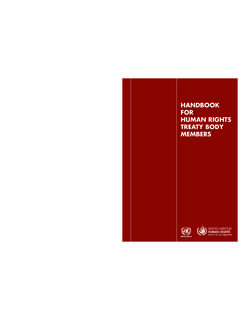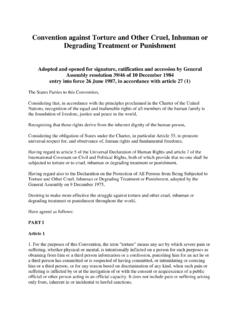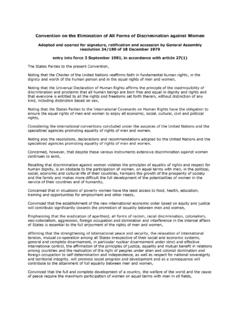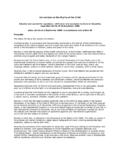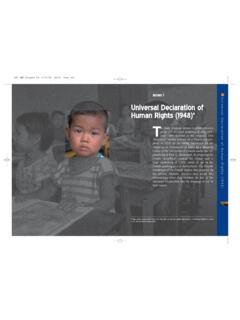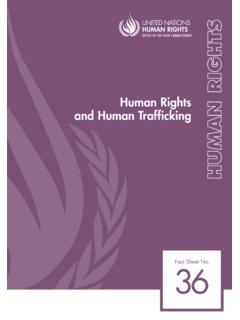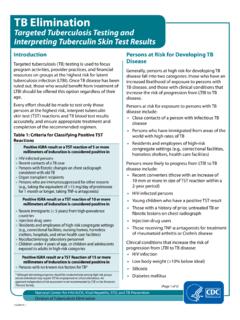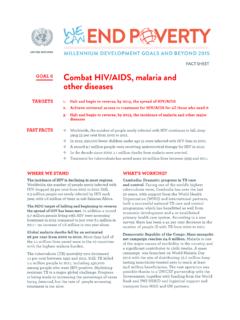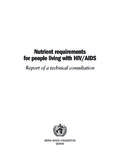Transcription of International Guidelines on HIV/AIDS and Human Rights
1 International Guidelines on HIV/AIDS and Human Rights 2006 Consolidated Version Second International Consultation on HIV/AIDS and Human Rights Geneva, 23-25 September 1996. Third International Consultation on HIV/AIDS and Human Rights Geneva, 25-26 July 2002. Organized jointly by the Of ce of the United Nations High Commissioner for Human Rights and the Joint United Nations Programme on HIV/AIDS . O F F I C E O F T H E U N I T E D N AT I O N S. HIGH COMMISSIONER. FOR Human Rights . Material contained in this publication may be freely quoted or reprinted, provided credit is given and a copy containing the reprinted material is sent to the Of ce of the United Nations High Commissioner for Human Rights , CH-1211 Geneva 10, and to UNAIDS, CH-1211 Geneva 27, Switzerland.
2 The designations employed and the presentation of the material in this publication do not imply expression of any opinion whatsoever on the part of the Secretariat of the United Nations or UNAIDS. concerning the legal status of any country, territory, city or area, or of its authorities, or concerning the delimitation of its frontiers or boundaries. Published jointly by the Of ce of the United Nations High Commissioner for Human Rights and the Joint United Nations Programme on HIV/AIDS . HR/PUB/06/9. UN PUBLICATION Sales No. ISBN 92-1-154168-9. Joint United Nations Programme on HIV/AIDS (UNAIDS) 2006.
3 All Rights reserved. Publications produced by UNAIDS can be obtained from the UNAIDS Information Centre. Requests for permission to translate UNAIDS publications whether for sale or for noncommercial distribution should also be addressed to the Information Centre at the address below, or by fax, at +41. 22 791 4187, or e-mail: UNAIDS does not warrant that the information contained in this publication is complete and correct and shall not be liable for any damages incurred as a result of its use. Printed in Switzerland OHCHR Tel: (+41) 22 917 9000 Palais des Nations Fax: (+41) 22 917 9008 CH-1211 Geneva 10.
4 Switzerland UNAIDS Tel: (+41) 22 791 36 66 20 avenue Appia Fax: (+41) 22 791 41 87 CH-1211 Geneva 27. Switzerland Of ce of the United Nations High Commissioner for Human Rights and the Joint United Nations Programme on HIV/AIDS . International Guidelines on HIV/AIDS and Human Rights 2006 Consolidated Version1. Second International Consultation on HIV/AIDS and Human Rights Geneva, 23-25 September 1996. Third International Consultation on HIV/AIDS and Human Rights Geneva, 25-26 July 2002. Organized jointly by the Of ce of the United Nations High Commissioner for Human Rights and the Joint United Nations Programme on HIV/AIDS .
5 O F F I C E O F T H E U N I T E D N AT I O N S. HIGH COMMISSIONER. FOR Human Rights . 1 Editor's note: This version of the International Guidelines on HIV/AIDS and Human Rights consolidates the Guidelines rst published in 1998 and revised Guideline 6 rst published in 2002. Because of the consolidation, paragraph numbering has changed, and references to the Guidelines should include reference to the consolidated version to avoid confusion as to paragraph numbering. Other minor editorial changes have been made with regard to the introduction, summary and use of some terms. For example, HIV/AIDS is usually shortened to HIV and is intended to include both conditions, and PLWHA has been changed to PLHIV.
6 Other than that, the content of the Guidelines has not been revised or altered. UNAIDS OHCHR. CONTENTS. Foreword 4. Glossary 8. Introduction 9. Background and summary of the Guidelines 13. I. Guidelines FOR STATE ACTION 20. A Institutional responsibilities and processes 21. B Law review, reform and support services 26. C Promotion of a supportive and enabling environment 52. II. RECOMMENDATIONS FOR DISSEMINATION AND. IMPLEMENTATION OF THE Guidelines ON. HIV/AIDS AND Human Rights 69. A States 69. B United Nations system and regional intergovernmental bodies 71. C Non-governmental organizations 74.
7 III. International Human Rights OBLIGATIONS AND HIV 77. A Human Rights standards and the nature of State obligations 79. B Restrictions and limitations 81. C The application of speci c Human Rights in the context of the HIV epidemic 83. 2. International Guidelines on HIV/AIDS and Human Rights Annex 1. History of the recognition of the importance of Human Rights in the context of HIV 105. Annex 2. List of participants at the Second International Consultation on HIV/AIDS and Human Rights 112. Annex 3. List of participants at the Third International Consultation on HIV/AIDS and Human Rights 114.
8 3. UNAIDS OHCHR. Foreword It has been ten years since the International Guidelines were adopted by the Second International Consultation on HIV/AIDS and Human Rights in 1996. In terms of the fast and ever-evolving epidemic, much has happened in this decade, both good and bad. Evidence of the effectiveness of a treatment for HIV. was rst announced in 1996, which for many changed HIV from a situation of hopelessness to a manageable health condition. But as the HIV epidemic cast its glaring light on the vast inequity in health care across the globe, people living with HIV, among others, began to demand that something be done about the fact that millions were dying of a treatable condition.
9 In 2001, the Commission on Human Rights adopted a resolution in which it stated that the right to the highest attainable standard of health includes access to antiretroviral therapy for HIV. Following this, in 2002, OHCHR and UNAIDS. sponsored the Third International Consultation on HIV/AIDS and Human Rights in order to revise Guideline 6 (consolidated into this reprint) to re ect the Human Rights dimensions of access to HIV. prevention, treatment, care and support. Widespread access to antiretrovirals, as well as to HIV. prevention, care and support, remains a major global health and Human Rights emergency for millions in need.
10 Nonetheless, the numbers of those having such access is rising. In this regard, governments and the International community made commitments in 2006 to pursue all necessary efforts towards achieving the goal 4. International Guidelines on HIV/AIDS and Human Rights of universal access to comprehensive HIV prevention programmes, treatment, care and support by 2010. Other time-bound com- mitments (including on Human Rights relating to HIV), have been made during the decade in the Millennium Declaration, and in the Declaration of Commitment adopted by the UN General Assembly Special Session on HIV/AIDS in 2001 and con rmed and expanded by the Political Declaration of the 2006 High Level Meeting on aids at the General Assembly.
